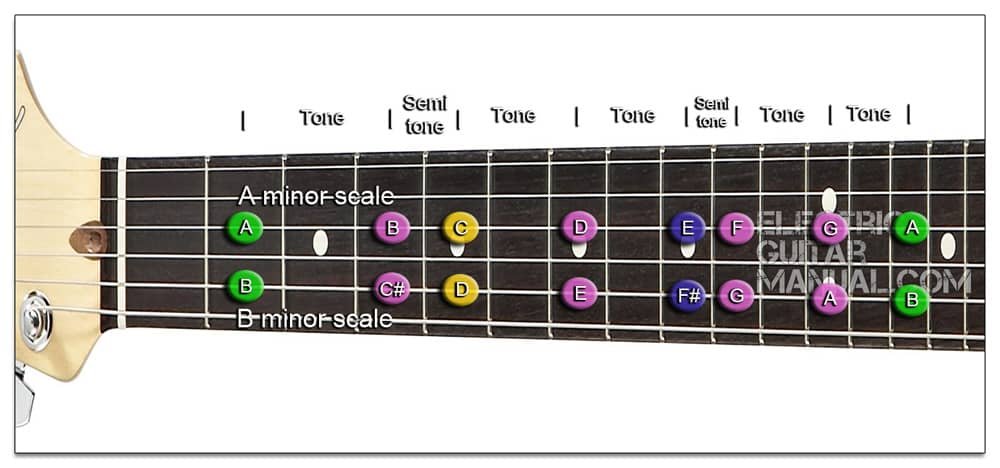KNOW the Music Intervals of the Diatonic Major Scale and Natural Minor Scale. The Musical Interval is about the Tonal Space between Different Notes.
In most scales that space is usually a semitone (one fret) or a tone (two frets). Although in scales like the Harmonic minor, that space between notes reaches up to the most semitone tone (three frets).
Music Intervals: Diatonic Major Scale
For example, between the notes of E and F of the C Major scale, there is an interval of one semitone, as well as between B and C. The rest of the notes in the scale have an interval of one tone.

In the image above we have the C Major and F Major scales. As these are two major scales, the intervals are the same, but the 4th note of the F scale has changed to B Flat to respect the intervals corresponding to a Major scale.
That note takes the name flat and not sharp, because if we put it in sharp there would be two Notes of A (A and A#), and yet there would be no B.
The F scale or the Key of F is one of the simplest, since it only has one flat. The Key of B becomes more complicated since this scale has five sharps. Consequently, we would have to pull barre chords to be able to play in that key with ease.
Why not play everything in the same key, and get rid of problems?
Thing about different keys is necessary, if we take into account the tone of our singer’s voice, or the level that he can reach. Or to be able to make key changes within the same song, to remove monotony from the musical theme. That’s what the different keys are for, to choose the one that best suits us at each moment, and in each song.
Music Intervals: Natural minor Scale
The natural minor scale takes the intervals of the Major scale, but in a different order. Since the key that has all its notes intact is the key of A minor (A – B – C – D – E – F – G). Unlike the tone of C in the case of the Major scale, but the structure and notes are the same.
That is, we can play a guitar solo with the C Major scale, but taking the note A as the Tonic, and we would already be playing in A minor. That is why the note A is called Relative Minor in the C Major scale and it occupies 6th place in all Major scales.
If we want to find out, and this is important, what the relative minor of a Major scale is, the sixth note of that Major scale tells us.

As seen in the graph, D would be the relative minor of the key of F Major, and the same would happen in the rest of the Major scales.
Intervals of the natural minor scale:

I mentioned earlier that the key of B major had five sharps, however in B minor it only has two sharps (C# – F#). Likewise, the tone of A does not have any note variation in a minor key, but in Major it consists of three sharps.
Scale Notes Chart: Major and Minor
Learning all the variations of the twelve tones of the Chromatic scale (C – C# – D – D# – E – F – F# – G – G# – A – A# – B), in Major and Minor, is something unnecessary and very complicated. So on the page “Notes of the Major and Minor scale“, I leave you some reference boxes to know which notes to use in each key, and what type of chord to use depending on its position in the scale.
